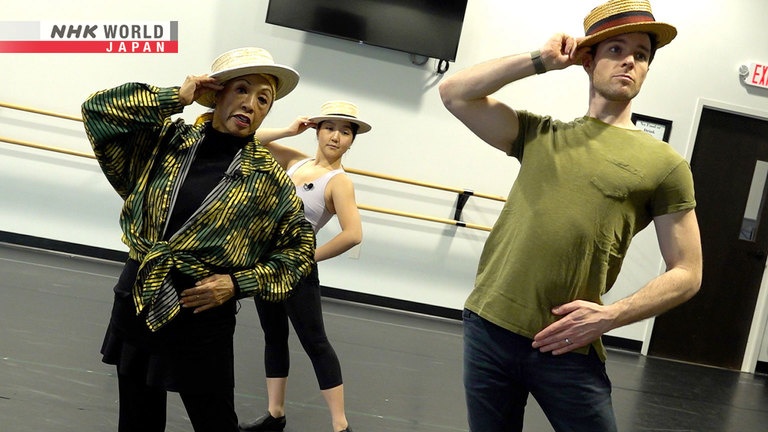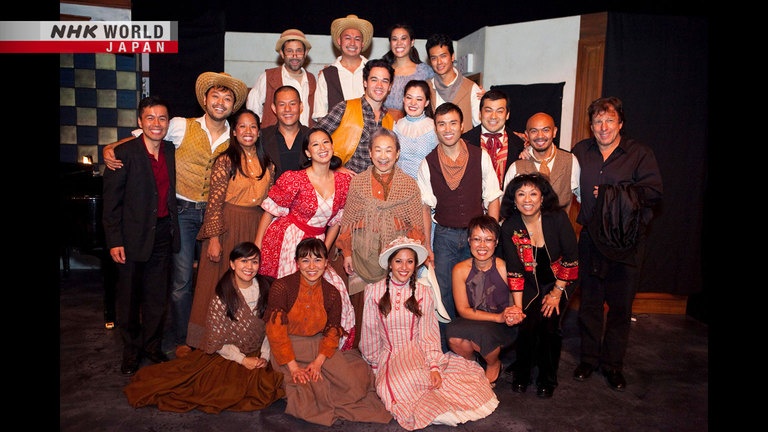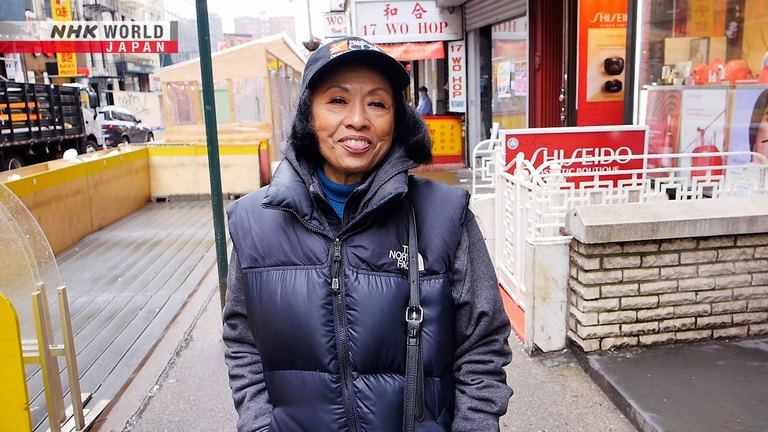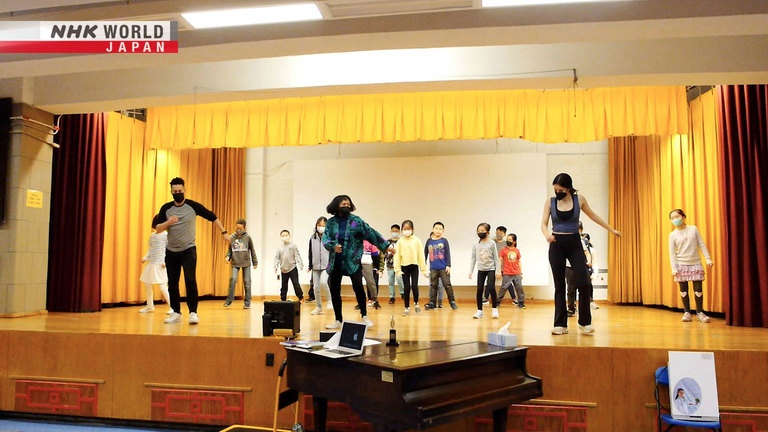Broadway Diversified by Asian Power: Baayork Lee / Co-founder of National Asian Artists Project
A legendary New York actor and director best known for playing Connie in "A Chorus Line" now strives to create opportunities for Asian performers. She talks about racial diversity in American theater.




Transcript
Direct Talk
In New York's Chinatown,
Asian elementary school students are
energetically working on a musical rehearsal
as an after-school activity.
The instructors are Broadway professionals!
The project is organized by a
non-profit organization called NAAP,
the National Asian Artists Project.
National Asian Artists Project (NAAP)
The well-known actor and director
Baayork Lee,
one of its co-founders,
is breathing fresh air
into the American theater world.
When I started to direct shows,
that's when my eyes really opened to see
that the Asian actors and singers and dancers
had no opportunities.
Baayork will talk about racial diversity
in the American theater community
and the role played by NAAP.
Broadway Diversified by Asian Power
As an Asian performer,
Baayork Lee has long been active
on the Broadway stage.
She's best known for her appearance in
"A Chorus Line,"
the musical that became a smash hit
when it premiered in 1975.
Baayork played
one of the lead dancers in the premiere
and joined the ranks of the stars.
She's currently working on various
initiatives for Asian theater artists.
The purpose of NAAP,
which is National Asian Artists Project,
is to be able to give a platform
for the Asian American
theater performers to meet,
East meeting the West,
which means that they will be able to
perform Western musicals and plays.
The opportunities for Asian-American actors
is not there,
because they are not hired
to be playing in western shows.
And so, if you're not doing The King and I
or Miss Saigon
or Flower Drum Song,
they have no work.
So many out-of-work actors,
they cannot afford singing lessons
and to keep their voices up.
And so we formed a choir
for them to come once a week
to sing different composers
and to keep their voices in shape.
NAAP provides acting coaching,
remote instruction
and audition referrals,
and it has so far supported
more than 2,000 artists.
NAAP also holds its own performances
and creates opportunities
for artists to perform.
We have many, many programs for them.
And what we do is we ask writers from NYU,
from Columbia, professionals,
to submit their new musicals.
We take four of them,
we cut them down for 30 minutes.
And we have Asian actors performing in them.
We also have "Rediscover,"
which is the big musicals
like Oklahoma!,
Carousel, Hello Dolly,
Into the Woods.
What else have we done? Cinderella,
that is to rediscover these musicals
with all-Asian cast.
Baayork has been putting on innovative shows
in which all characters
previously performed by white artists
are presented by Asians.
"Oliver!"
Thanks to her challenging new concepts,
the attention paid to Asian artists
in the American theater community
is increasing year by year.
"Oklahoma!"
We will also hopefully start doing plays
and comedies,
and Shakespeare,
all of these things are there
the umbrella is very wide for NAAP,
to introduce all of this to our community,
because we are building a community
and making them aware of all of these things
that are available to them.
And also having an audience wanting to
come to see Asians doing Shakespeare,
Asians doing comedies,
and all of those things.
It's very, very important.
The United States is known
as a racial "melting pot,"
but until the early years of this century,
only a very limited number of non-white performers
could appear on the Broadway stage.
In recent years, however,
the number has gradually started to rise.
In the past few years, yes.
There are more of diversity on Broadway,
on television, in movies. Absolutely.
But I really feel that the push came
during the pandemic and Black Lives Matter.
What's happening now is
that all of those people,
the producers, the writers,
the casting people,
they are opening up
and seeing that we need to,
to really across the board
have as much diversity as possible.
I think it is become more aware.
Baayork was born here in
New York's Chinatown in 1946,
to a Chinese father and an Indian mother.
And New York was a boundary.
We had Germantown,
we had Little Italy,
we had, you know, Chinatown.
Oh, yes, there were definitely boundaries.
We never passed 14th street
because there was no need.
Everything was below 14th Street.
It was an appearance in the musical
"The King and I"
that introduced Baayork
to the world of show business.
"The King and I"
Starring Yul Brynner & Gertrude Lawrence
She played one of the daughters
of the Thai king,
originally played by Yul Brynner.
Baayork Lee (aged 5)
In Chinatown, we did not have theater.
We didn't know what Broadway was.
And so for a casting agent
to go to Chinatown looking for children
for the King and I with Yul Brynner
was very unusual.
When I got to the theater,
and I saw a chandelier for the first time,
I saw people dancing on the stage,
I loved it,
and at five I said to my mother,
"This is what I want to do!"
She was eager to pursue a stage career.
However, times were tough
for Asian performers.
I can see the hardship for the Asian actors
dancers, singers in those days,
because they were not hired at all.
Against such a backdrop, she found a way out.
My journey has been wonderful,
because in all of the shows,
I would say, I was able to work as a kid,
because I was not tall enough.
And at the age of 28,
her destiny was shaped by her performance
in that famous production
of "A Chorus Line."
It's a story about the hopes and
disappointments of unknown dancers.
Baayork played the role of
an Asian American called Connie Wong.
We have this Asian character.
And it was really important for my community
that we were recognized.
Michael Bennett always, always,
always had diversity in his companies.
This was just his way of,
of using the people that he loved to work with.
There's so many Asian girls whose career
started with A Chorus Line.
This role is very important
for an Asian actress/singer.
Today, 47 years since the first performance,
Baayork is active
as a director of "A Chorus Line."
And I want you to sit in the hip,
so that there's an S shape.
Correct.
5,6,7,8
One change
Walk
Walk
Point
Point, Point!
Flip, step, kick.
Hold.
It's really hard for me
to start to direct the Connies
because it's my life.
Faster than anybody else,
and be better than anybody else.
Absolutely.
And then only has to be with short.
Can you imagine being Asian,
also you know you gotta
something else on top of that.
When I first got to school,
when I was training at the Conservatory,
I had people coming up to me telling me,
"Oh, you'd be a great Connie Wong!"
And to be told that to do this iconic role.
And to be able to do it now is such a dream.
For the past two years, Asian-Americans
have been the target of hate crimes,
and protest demonstrations
have been held in various cities.
What does Baayork think about
this current reality?
What can I say about Asian hate, you know?
I think for so many years,
our community was very, very passive.
And, you know,
felt like second-class citizens.
We always sat back,
we never pushed for anything.
I think it's part of the culture
to wait and see what's gonna happen.
And now we have this fourth,
fifth generation who are born here,
and they don't know what is in
China or in Japan or Vietnam,
they are here
and they are going to stand up for their rights.
I think the push now is
that the younger generation,
they are not going to wait.
They are going to voice their opinion
and they want to be heard
and they want to be seen.
They want to be visible.
"As Asians, we no longer need to wait,
we need to speak up for ourselves."
It was this desire
that drove her to establish NAAP.
As well as teaching professionals,
Baayork is involved in
another important initiative.
It's an activity for elementary schools
called "Theater Club."
Baayork provides the children
with acting practice.
The activity is organized by NAAP,
and the operating funds are
managed through donations and bazaar sales.
I joined this year.
Because I really like singing and dancing.
You get to meet other people
and work with them.
And you get also to learn dance moves
and you get to have fun.
I want to give them
the same opportunity that I had.
What they take away is the discipline,
the camaraderie,
vocal abilities,
their speech.
And I am making them aware
that there is something outside
of the school and of Chinatown,
and also taking them uptown now
to see shows, and also to go backstage.
When they come to the theatre club,
they are free to speak and to be themselves.
That is the first education
that they can think for themselves.
If they want to be in theater,
as I said, I have children at LaGuardia
and some are, you know, gone on,
but if they don't want to be in theater,
we also need people to buy the tickets
and they will appreciate going to the theater
because they understand it.
The various awards for her contributions to
the theater community and educational programs
include the non-competitive,
philanthropic Isabelle Stevenson Tony Award.
Now, we need Asian writers,
Asian producers, Asian directors,
who are going to not only write for us,
but tell our stories, and hire us.
We have been invisible and very silent about
being an actor or being Asian or whatever.
But now we are visible.
We are uniting
and protesting
and making more people aware that we are here
and we are not going anywhere,
that we eat hamburgers and mac and cheese
like everybody else.
And we are going to stand our ground.
Baayork continues to influence many people
of Asian descent living in America.
So, what is her motto?
Never give up your dream!
It's really important that
if you really want to be in the theater,
you really want to be in this business,
you don't give up.
There's always a show for you.
There's a place for you,
and it's really important
that you see it through to the end.